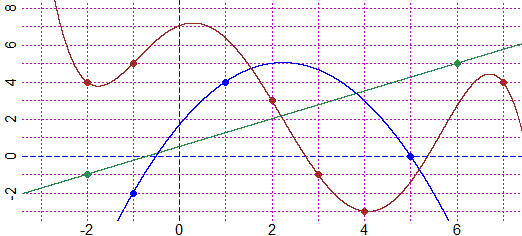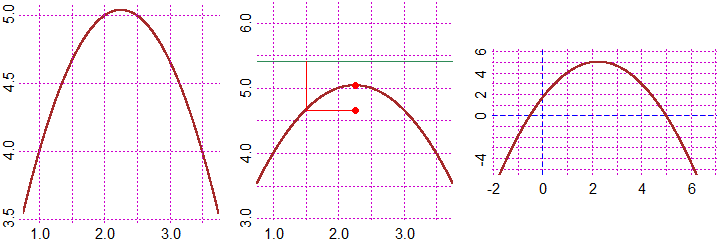source("http://macosa.dima.unige.it/r.R") # If I have not already loaded the library
---------- ---------- ---------- ---------- ---------- ---------- ---------- ----------
# You can find the minimum degree polynomial whose graph goes through some points
# with the commands: xy_2(…) (2 points), …, xy_7(…) (7), xy_fr() (fractional form).
# From the points: (-2,-1) (6,5) to the polynomial:
# 1/2 + 3/4*x
# From the points: (-1,-2) (1,4) (5,0) to the polynomial:
# 5/3 + 3*x - 2/3*x^2
# From the points: (-2,4) (-1,5) (2,3) (3,-1) (4,-3) (7,4) to the polynomial:
# 211/30 + 341/360*x - 3/2*x^2 - 71/288*x^3 + 37/240*x^4 - 19/1440*x^5
 BF=6; HF=3
Plane(-3,7,-3,8)
POINT(c(-2,6), c(-1,5), "seagreen")
xy_2(c(-2,6), c(-1,5))
# = function(x) 0.5 + 0.75 *x Then I define:
f= function(x) 0.5 + 0.75 *x
graph1(f, -4,8, "seagreen")
POINT(c(-1,1,5), c(-2,4,0), "blue")
xy_3(c(-1,1,5), c(-2,4,0))
# = function(x) 1.666667 + 3 *x + -0.6666667 *x^2
xy_fr()
# 5/3 3 -2/3 Then I define:
# f= function(x) 1.666667 + 3 *x + -0.6666667 *x^2 or:
f= function(x) 5/3 + 3*x -2/3*x^2
graph1(f, -4,8, "blue")
POINT(c(-2,-1,2,3,4,7), c(4,5,3,-1,-3,4),"brown")
xy_6(c(-2,-1,2,3,4,7), c(4,5,3,-1,-3,4))
# = function(x) 7.033333 + 0.9472222 *x + -1.5 *x^2 + -0.2465278 *x^3 + 0.1541667 *x^4 + -0.01319444 *x^5
xy_fr()
# 211/30 341/360 -3/2 -71/288 37/240 -19/1440 Then I define:
f= function(x) 211/30 + 341/360*x - 3/2*x^2 - 71/288*x^3 + 37/240*x^4 + -19/1440*x^5
graph1(f, -4,8, "brown")
# You can automatically plot the graph of a 2nd-degree polynomial function and find its
# vertex and focus, with the Parabola and ParabolaM commands:
# y = -2/3*x^2 + 3*x + 5/3 V: 9/4 121/24 F: 9/4 14/3
BF=6; HF=3
Plane(-3,7,-3,8)
POINT(c(-2,6), c(-1,5), "seagreen")
xy_2(c(-2,6), c(-1,5))
# = function(x) 0.5 + 0.75 *x Then I define:
f= function(x) 0.5 + 0.75 *x
graph1(f, -4,8, "seagreen")
POINT(c(-1,1,5), c(-2,4,0), "blue")
xy_3(c(-1,1,5), c(-2,4,0))
# = function(x) 1.666667 + 3 *x + -0.6666667 *x^2
xy_fr()
# 5/3 3 -2/3 Then I define:
# f= function(x) 1.666667 + 3 *x + -0.6666667 *x^2 or:
f= function(x) 5/3 + 3*x -2/3*x^2
graph1(f, -4,8, "blue")
POINT(c(-2,-1,2,3,4,7), c(4,5,3,-1,-3,4),"brown")
xy_6(c(-2,-1,2,3,4,7), c(4,5,3,-1,-3,4))
# = function(x) 7.033333 + 0.9472222 *x + -1.5 *x^2 + -0.2465278 *x^3 + 0.1541667 *x^4 + -0.01319444 *x^5
xy_fr()
# 211/30 341/360 -3/2 -71/288 37/240 -19/1440 Then I define:
f= function(x) 211/30 + 341/360*x - 3/2*x^2 - 71/288*x^3 + 37/240*x^4 + -19/1440*x^5
graph1(f, -4,8, "brown")
# You can automatically plot the graph of a 2nd-degree polynomial function and find its
# vertex and focus, with the Parabola and ParabolaM commands:
# y = -2/3*x^2 + 3*x + 5/3 V: 9/4 121/24 F: 9/4 14/3
 # I introduce only the coefficients. The scale and the window are chosen automatically.
# The coordinates of the vertex are printed.
Parabola(-2/3,3,5/3)
# y=a*x^2+b*x+c V: 2.25 5.041667 [1] 9/4 121/24
# I introduce only the coefficients. The monometric scale and the window are chosen
# automatically. The coordinates of the vertex and the focus are printed.
# Vertex, focus and directrix are drown. The points of the parabola are equidistant
# from both the directrix and the focus.
ParabolaM(-2/3,3,5/3)
# y = a*x^2 + b*x + c
# V: 2.25 5.041667 [1] 9/4 121/24
# F: 2.25 4.666667 [1] 9/4 14/3
# The graph with the usual command:
F = function(x) -2/3*x^2+3*x+5/3
Plane(-2,7, -5,6)
graph2(F,-3,8, "brown")
# For the general theme of the conics see here.
Other examples of use
# I introduce only the coefficients. The scale and the window are chosen automatically.
# The coordinates of the vertex are printed.
Parabola(-2/3,3,5/3)
# y=a*x^2+b*x+c V: 2.25 5.041667 [1] 9/4 121/24
# I introduce only the coefficients. The monometric scale and the window are chosen
# automatically. The coordinates of the vertex and the focus are printed.
# Vertex, focus and directrix are drown. The points of the parabola are equidistant
# from both the directrix and the focus.
ParabolaM(-2/3,3,5/3)
# y = a*x^2 + b*x + c
# V: 2.25 5.041667 [1] 9/4 121/24
# F: 2.25 4.666667 [1] 9/4 14/3
# The graph with the usual command:
F = function(x) -2/3*x^2+3*x+5/3
Plane(-2,7, -5,6)
graph2(F,-3,8, "brown")
# For the general theme of the conics see here.
Other examples of use
 BF=6; HF=3
Plane(-3,7,-3,8)
POINT(c(-2,6), c(-1,5), "seagreen")
xy_2(c(-2,6), c(-1,5))
# = function(x) 0.5 + 0.75 *x Then I define:
f= function(x) 0.5 + 0.75 *x
graph1(f, -4,8, "seagreen")
POINT(c(-1,1,5), c(-2,4,0), "blue")
xy_3(c(-1,1,5), c(-2,4,0))
# = function(x) 1.666667 + 3 *x + -0.6666667 *x^2
xy_fr()
# 5/3 3 -2/3 Then I define:
# f= function(x) 1.666667 + 3 *x + -0.6666667 *x^2 or:
f= function(x) 5/3 + 3*x -2/3*x^2
graph1(f, -4,8, "blue")
POINT(c(-2,-1,2,3,4,7), c(4,5,3,-1,-3,4),"brown")
xy_6(c(-2,-1,2,3,4,7), c(4,5,3,-1,-3,4))
# = function(x) 7.033333 + 0.9472222 *x + -1.5 *x^2 + -0.2465278 *x^3 + 0.1541667 *x^4 + -0.01319444 *x^5
xy_fr()
# 211/30 341/360 -3/2 -71/288 37/240 -19/1440 Then I define:
f= function(x) 211/30 + 341/360*x - 3/2*x^2 - 71/288*x^3 + 37/240*x^4 + -19/1440*x^5
graph1(f, -4,8, "brown")
# You can automatically plot the graph of a 2nd-degree polynomial function and find its
# vertex and focus, with the Parabola and ParabolaM commands:
# y = -2/3*x^2 + 3*x + 5/3 V: 9/4 121/24 F: 9/4 14/3
BF=6; HF=3
Plane(-3,7,-3,8)
POINT(c(-2,6), c(-1,5), "seagreen")
xy_2(c(-2,6), c(-1,5))
# = function(x) 0.5 + 0.75 *x Then I define:
f= function(x) 0.5 + 0.75 *x
graph1(f, -4,8, "seagreen")
POINT(c(-1,1,5), c(-2,4,0), "blue")
xy_3(c(-1,1,5), c(-2,4,0))
# = function(x) 1.666667 + 3 *x + -0.6666667 *x^2
xy_fr()
# 5/3 3 -2/3 Then I define:
# f= function(x) 1.666667 + 3 *x + -0.6666667 *x^2 or:
f= function(x) 5/3 + 3*x -2/3*x^2
graph1(f, -4,8, "blue")
POINT(c(-2,-1,2,3,4,7), c(4,5,3,-1,-3,4),"brown")
xy_6(c(-2,-1,2,3,4,7), c(4,5,3,-1,-3,4))
# = function(x) 7.033333 + 0.9472222 *x + -1.5 *x^2 + -0.2465278 *x^3 + 0.1541667 *x^4 + -0.01319444 *x^5
xy_fr()
# 211/30 341/360 -3/2 -71/288 37/240 -19/1440 Then I define:
f= function(x) 211/30 + 341/360*x - 3/2*x^2 - 71/288*x^3 + 37/240*x^4 + -19/1440*x^5
graph1(f, -4,8, "brown")
# You can automatically plot the graph of a 2nd-degree polynomial function and find its
# vertex and focus, with the Parabola and ParabolaM commands:
# y = -2/3*x^2 + 3*x + 5/3 V: 9/4 121/24 F: 9/4 14/3
 # I introduce only the coefficients. The scale and the window are chosen automatically.
# The coordinates of the vertex are printed.
Parabola(-2/3,3,5/3)
# y=a*x^2+b*x+c V: 2.25 5.041667 [1] 9/4 121/24
# I introduce only the coefficients. The monometric scale and the window are chosen
# automatically. The coordinates of the vertex and the focus are printed.
# Vertex, focus and directrix are drown. The points of the parabola are equidistant
# from both the directrix and the focus.
ParabolaM(-2/3,3,5/3)
# y = a*x^2 + b*x + c
# V: 2.25 5.041667 [1] 9/4 121/24
# F: 2.25 4.666667 [1] 9/4 14/3
# The graph with the usual command:
F = function(x) -2/3*x^2+3*x+5/3
Plane(-2,7, -5,6)
graph2(F,-3,8, "brown")
# For the general theme of the conics see here.
Other examples of use
# I introduce only the coefficients. The scale and the window are chosen automatically.
# The coordinates of the vertex are printed.
Parabola(-2/3,3,5/3)
# y=a*x^2+b*x+c V: 2.25 5.041667 [1] 9/4 121/24
# I introduce only the coefficients. The monometric scale and the window are chosen
# automatically. The coordinates of the vertex and the focus are printed.
# Vertex, focus and directrix are drown. The points of the parabola are equidistant
# from both the directrix and the focus.
ParabolaM(-2/3,3,5/3)
# y = a*x^2 + b*x + c
# V: 2.25 5.041667 [1] 9/4 121/24
# F: 2.25 4.666667 [1] 9/4 14/3
# The graph with the usual command:
F = function(x) -2/3*x^2+3*x+5/3
Plane(-2,7, -5,6)
graph2(F,-3,8, "brown")
# For the general theme of the conics see here.
Other examples of use